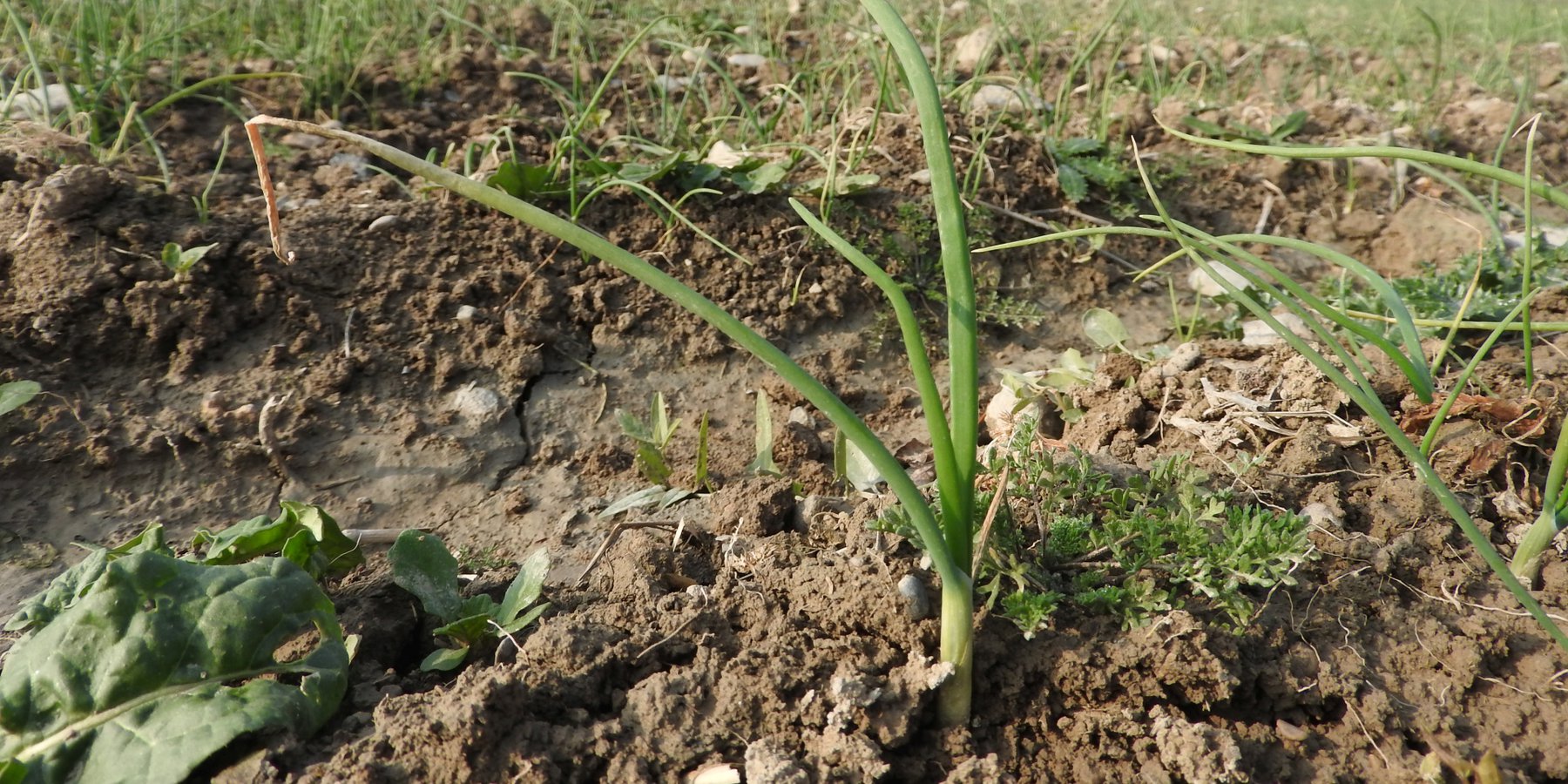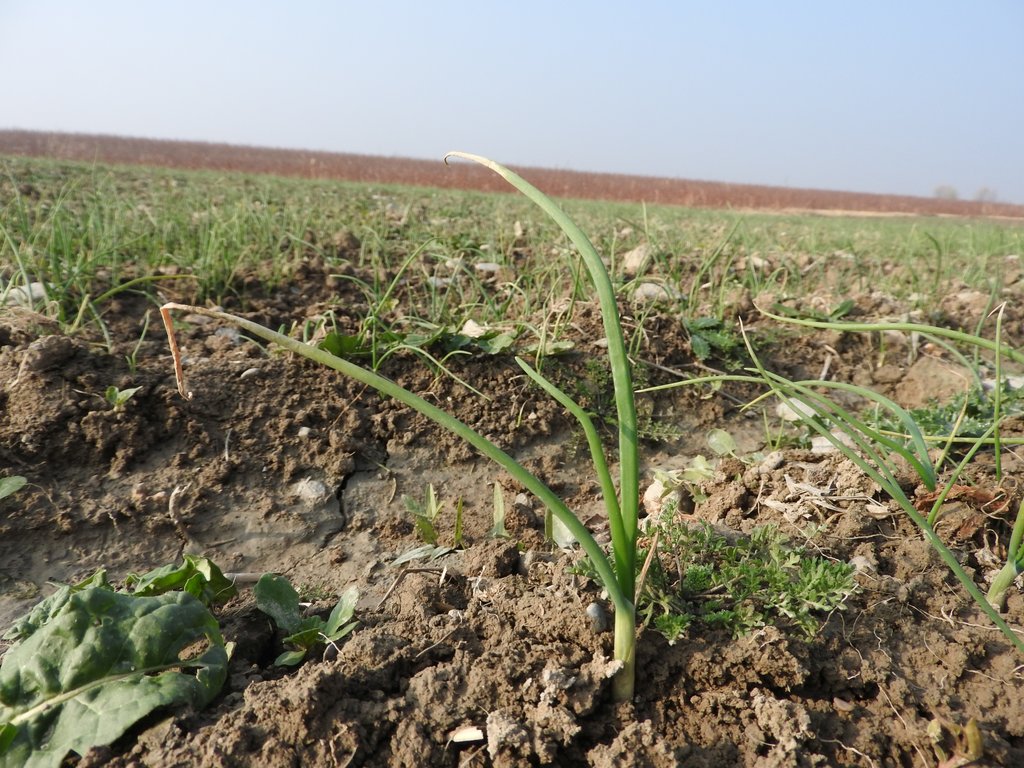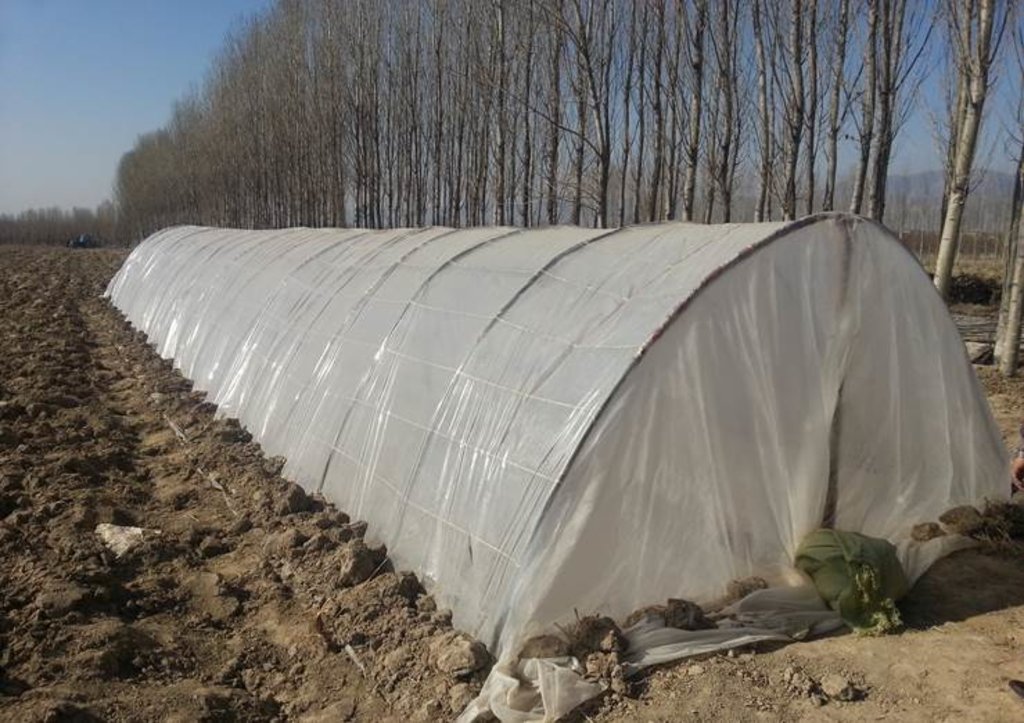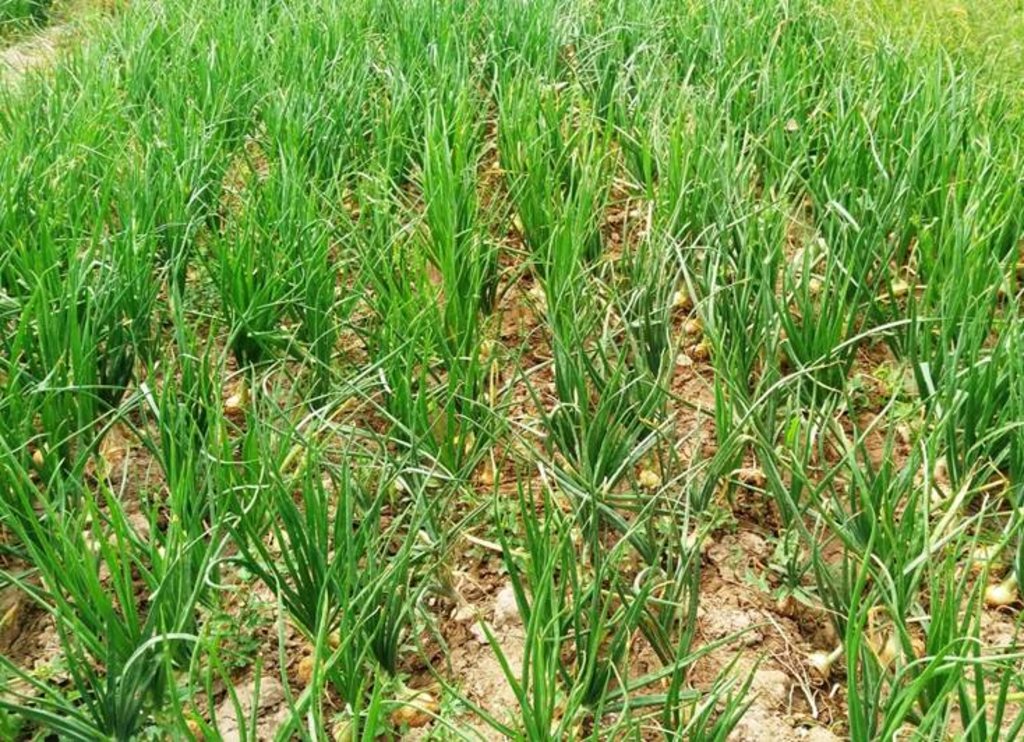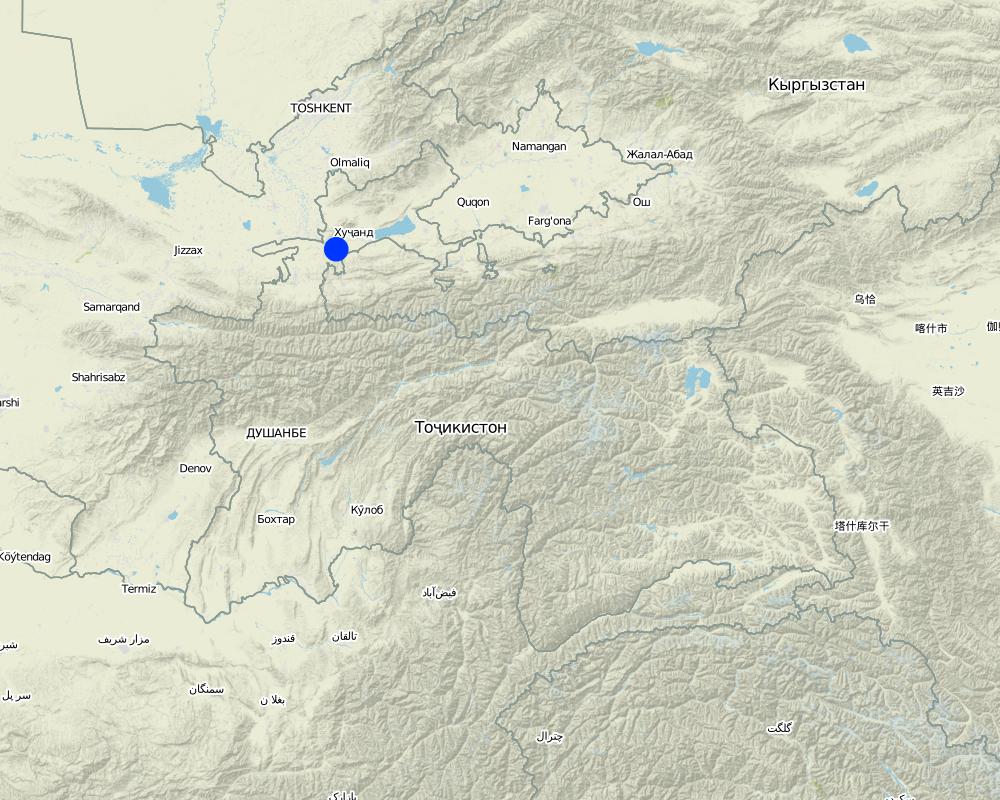Onion production by greenhouse propagation and transplantation [塔吉克斯坦]
- 创建:
- 更新:
- 编制者: Stefan Michel
- 编辑者: –
- 审查者: Umed Vahobov
Выращивание лука рассадным способом
technologies_4296 - 塔吉克斯坦
查看章节
全部展开 全部收起1. 一般信息
1.2 参与该技术评估和文件编制的资源人员和机构的联系方式
关键资源人
SLM专业人员:
Negmatov Negmatjon
Deutsche Gesellschaft für Internationale Zusammenarbeit (GIZ)
塔吉克斯坦
SLM专业人员:
Haydarov Abdusattor
NGO Neksigol
塔吉克斯坦
有助于对技术进行记录/评估的项目名称(如相关)
Strengthening of Livelihoods through Climate Change Adaptation in Kyrgyzstan and Tajikistan有助于对技术进行记录/评估的机构名称(如相关)
Deutsche Gesellschaft für Internationale Zusammenarbeit - Tajikistan (GIZ Tajikistan) - 塔吉克斯坦1.3 关于使用通过WOCAT记录的数据的条件
编制者和关键资源人员接受有关使用通过WOCAT记录数据的条件。:
是
1.4 所述技术的可持续性声明
这里所描述的技术在土地退化方面是否存在问题,导致无法被认为是一种可持续的土地管理技术?:
否
1.5 参考关于SLM方法(使用WOCAT记录的SLM方法)的调查问卷
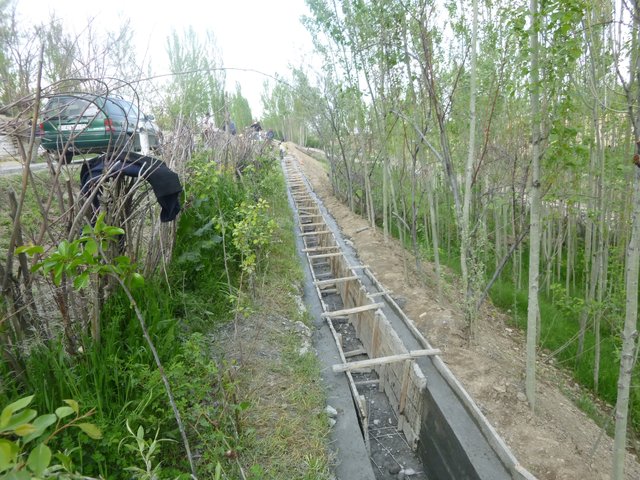
Increased efficiency of irrigation water use to address … [塔吉克斯坦]
Climate change impact contributes to irrigation water shortage. The approach of improving irrigation water delivery, distribution and use prevents irrigation water losses and increases the productivity per amount of irrigation water available.
- 编制者: Stefan Michel
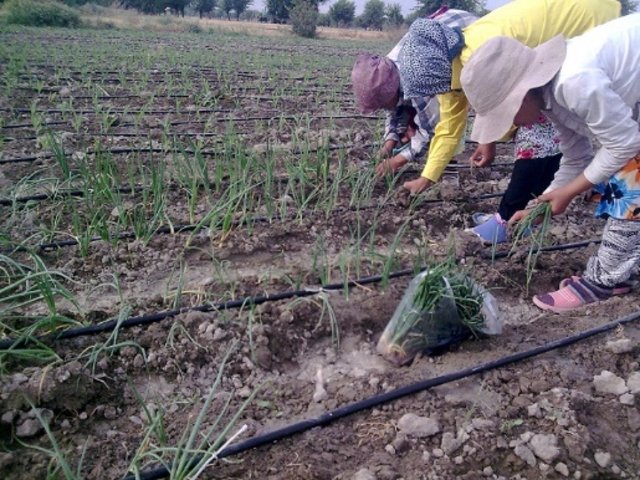
Integrated farming on irrigated lands for adaptation to … [塔吉克斯坦]
Irrigated agriculture faces challenges from climate change impact and growing competition for irrigation water. The approach to get "more crop per drop" reduces the adverse effect of these impacts and improves the income of farmers.
- 编制者: Stefan Michel
2. SLM技术的说明
2.1 技术简介
技术定义:
Onion seeds are sown in sheeting greenhouses, where the onion seedlings are propagated. The seedlings are then replanted in the open field. This makes them less prone to extreme weather events and provides higher yield of better quality.
2.2 技术的详细说明
说明:
The technology of greenhouse propagation of onion plants and transplantation is applied in intensive, irrigation dependent agricultural systems. The technology is based on sowing of onion seeds in a sheeting greenhouse, where the seedlings grow for 45 days. Afterwards the onion seedlings are replanted in the open field. By this technology the sensitive seedlings are propagated in a protective environment making them less vulnerable to unfavorable weather conditions, like late freezing or rainstorms. Due to ongoing climate change weather conditions become less predictable and extreme events become more frequent.
The propagation of onions in the greenhouse requires substantially less seeds than traditional hand sowing in the field – 4 kg/ha onion field instead of 16-18 kg, i.e. saving 75-77%. Furthermore the propagation of onion seedlings in greenhouses with transplanting allows for a reduced input of pesticides and fertilizer compared to sowing in the field. This reduction of agrochemical input is related to the small area and favorable conditions in the greenhouse during the propagation of the seedlings.
The technology requires the preparation of the field in fall with 30 cm deep ploughing, harrowing and planning (молование). Afterwards the furrows for planting are made. Complex mineral fertilizer “NitroAmmoPhosKa” (N 16%, P2O5 16%, K2O 16%) or “DiAmmoPhosKa” (N 16%, P 16%, K 16%) in an amount of 75 kg per ha is applied before the transplanting.
The onion seeds are in mid-March sown in a sheeting greenhouse with 4 kg seeds on 100 m². Together with the seeds 3 kg “NitroAmmoPhosKa” and some dung are applied as fertilizer. After 45 days the onion seedlings have reached the stage of three real leaves and are in their optimum growth stage for replanting into the field. The seedlings in the three-leaf stage are by hand planted on the open ground of the prepared as described field.
During the growth period the seedlings are one time weeded and fertilized as follows: i) during planting 75 kg/ha “NitroAmmoPhosKa” is applied; ii) another 100 kg/ha “NitroAmmoPhosKa” is applied in form of supplementary fertilizing (подкормка). Also other fertilizer has been applied in form of supplementary fertilizing (подкормка) 400 kg/ha “Selitra”, 200 kg/ha “Ammophos” and 200 kg/ha “Karbamid (46)”. The onion has also been treated with various pesticides. The field is 10 times irrigated during the vegetation season, requiring 8000 m³ of irrigation water.
The yield on test plots was 91,300 kg/ha. The harvested onions are more homogenous in size thus better marketable than those propagated conventionally.
The benefit of the technology is the reduced amount of seeds required, reduced costs of pesticides and fertilizer. Despite the costs of materials and the effort needed to establish the greenhouse and the additional work for transplanting the seedlings, the technology provides an economic net benefit to the farmer. In testing plots the net profit of traditional onion cultivation was 76% while with greenhouse propagation and transplanting a net profit of 192% would be achieved. Greenhouse propagation also protects the seedlings from failure caused by extreme weather events, which become more frequent due to climate change, and thus reduce the risk for the farmers.
2.3 技术照片
2.5 已应用该技术的、本评估所涵盖的国家/地区/地点
国家:
塔吉克斯坦
区域/州/省:
Sughd region
有关地点的进一步说明:
J. Rasulov district
具体说明该技术的分布:
- 适用于特定场所/集中在较小区域
技术现场是否位于永久保护区?:
否
注释:
So far only single farmers apply the technology.
Map
×2.6 实施日期
注明实施年份:
2016
2.7 技术介绍
详细说明该技术是如何引入的:
- 在实验/研究期间
- 通过项目/外部干预
注释(项目类型等):
Demonstration plots have been established and monitored by the NGO Neksigol with support by the GIZ project.
3. SLM技术的分类
3.1 该技术的主要目的
- 改良生产
- 适应气候变化/极端天气及其影响
- 创造有益的经济影响
3.2 应用该技术的当前土地利用类型
同一土地单元内混合使用的土地::
否

农田
- 一年一作
年作 - 具体指明作物:
- 谷类 - 小麦(春季)
- 纤维作物 - 棉花
- 油料作物 - 向日葵、菜籽、其他
- 蔬菜 - 根茎类蔬菜(胡萝卜、洋葱、甜菜等)
每年的生长季节数:
- 1
采用轮作制度了吗?:
是
3.3 由于技术的实施,土地使用是否发生了变化?
由于技术的实施,土地使用是否发生了变化?:
- 否(继续问题3.4)
3.4 供水
该技术所应用土地的供水:
- 充分灌溉
3.5 该技术所属的SLM组
- 改良植物品种/动物品种
- imoroved vegetable cultivation
3.6 包含该技术的可持续土地管理措施

农艺措施
- A5:种子管理,改良品种
- A7:其它
3.8 防止、减少或恢复土地退化
具体数量名该技术与土地退化有关的目标:
- 不适用
4. 技术规范、实施活动、投入和成本
4.2 有关投入和成本计算的一般信息
具体说明成本和投入是如何计算的:
- 每个技术区域
注明尺寸和面积单位:
hectare
其它/国家货币(具体说明):
TJS
如相关,注明美元与当地货币的汇率(例如1美元=79.9巴西雷亚尔):1美元=:
8.0
注明雇用劳工的每日平均工资成本:
20-50
4.4 技术建立所需要的费用和投入
注释:
We did not differentiate establishment and recurrent activities, as this is a technology to be integrated in the overall cycle of agricultural works.
4.5 维护/经常性活动
| 活动 | 时间/频率 | |
|---|---|---|
| 1. | Preparation of greenhouse field (100 m²) | February-March/once per annum |
| 2. | Establishment of sheeting greenhouse | February-March/once per annum |
| 3. | Sowing onion seeds and care | March-April/once per annum |
| 4. | Transplanting of seedlings | End April/once per annum |
| 5. | Ploughing of field, harrowing, planning, making furrows | Before transplanting/once per annum |
| 6. | Fertilizing | Before transplanting, during vegetation |
| 7. | Irrigation | 10 times during vegetation season |
| 8. | Application of pesticides | 5 times during vegetation season |
| 9. | Weeding | 3 times during vegetation season |
| 10. | Harvest | Once per annum |
注释:
We did not differentiate establishment and recurrent activities, as this is a technology to be integrated in the overall cycle of agricultural works.
4.6 维护/经常性活动所需要的费用和投入(每年)
| 对投入进行具体说明 | 单位 | 数量 | 单位成本 | 每项投入的总成本 | 土地使用者承担的成本% | |
|---|---|---|---|---|---|---|
| 劳动力 | Preparation of greenhouse field (100 m²) | person | 1.0 | 50.0 | 50.0 | 100.0 |
| 劳动力 | Establishment of greenhouse | person | 1.0 | 50.0 | 50.0 | 100.0 |
| 劳动力 | Sowing onion seeds and care (over 45 days) | person | 2.0 | 50.0 | 100.0 | 100.0 |
| 劳动力 | Agrotechnical works | ha | 1.0 | 820.0 | 820.0 | 100.0 |
| 设备 | Sheeting | m | 50.0 | 1.0 | 50.0 | 100.0 |
| 植物材料 | Seeds | kg | 4.0 | 685.0 | 2740.0 | 100.0 |
| 植物材料 | Transplanting | 1.0 | 1520.0 | 1520.0 | 100.0 | |
| 肥料和杀菌剂 | Politrin ka | l | 1.0 | 200.0 | 200.0 | 100.0 |
| 肥料和杀菌剂 | Mospilan | kg | 0.4 | 100.0 | 40.0 | 100.0 |
| 肥料和杀菌剂 | Goal | l | 0.6 | 220.0 | 132.0 | 100.0 |
| 肥料和杀菌剂 | Other pesticides | Total | 1.0 | 2371.0 | 2371.0 | 100.0 |
| 肥料和杀菌剂 | Ammonium Nitrate | 50 kg | 8.0 | 120.0 | 960.0 | 100.0 |
| 肥料和杀菌剂 | NitroAmmoPhosKa | 50 kg | 4.8 | 240.0 | 1152.0 | 100.0 |
| 肥料和杀菌剂 | Ammophos | 50 kg | 4.0 | 160.0 | 640.0 | 100.0 |
| 肥料和杀菌剂 | Karbamid (46) | 50 kg | 4.0 | 130.0 | 520.0 | 100.0 |
| 施工材料 | 2.0 | |||||
| 其它 | Irrigation | times | 10.0 | 50.0 | 500.0 | 100.0 |
| 其它 | Irrigation water | m³ | 8000.0 | 0.018 | 144.0 | 100.0 |
| 其它 | Application of pesticides | times | 5.0 | 50.0 | 250.0 | 100.0 |
| 其它 | Weeding | times | 3.0 | 500.0 | 1500.0 | 100.0 |
| 其它 | Harvest | ha | 1.0 | 4000.0 | 4000.0 | 100.0 |
| 其它 | Miscellaneous expenses | 1.0 | 1000.0 | 1000.0 | 100.0 | |
| 技术维护所需总成本 | 18739.0 | |||||
| 技术维护总成本,美元 | 2342.38 | |||||
注释:
We did not differentiate establishment and recurrent activities, as this is a technology to be integrated in the overall cycle of agricultural works.
4.7 影响成本的最重要因素
描述影响成本的最决定性因素:
Transplanting is an important additional cost factor, compared to conventional sowing. However, costs for seeds is lower despite of use of higher quality seeds of certified sorts.
5. 自然和人文环境
5.1 气候
年降雨量
- < 250毫米
- 251-500毫米
- 501-750毫米
- 751-1,000毫米
- 1,001-1,500毫米
- 1,501-2,000毫米
- 2,001-3,000毫米
- 3,001-4,000毫米
- > 4,000毫米
指定年平均降雨量(若已知),单位为mm:
246.00
注明所考虑的参考气象站名称:
Mehrobod
农业气候带
- 半干旱
5.2 地形
平均坡度:
- 水平(0-2%)
- 缓降(3-5%)
- 平缓(6-10%)
- 滚坡(11-15%)
- 崎岖(16-30%)
- 陡峭(31-60%)
- 非常陡峭(>60%)
地形:
- 高原/平原
- 山脊
- 山坡
- 山地斜坡
- 麓坡
- 谷底
垂直分布带:
- 0-100 m a.s.l.
- 101-500 m a.s.l.
- 501-1,000 m a.s.l.
- 1,001-1,500 m a.s.l.
- 1,501-2,000 m a.s.l.
- 2,001-2,500 m a.s.l.
- 2,501-3,000 m a.s.l.
- 3,001-4,000 m a.s.l.
- > 4,000 m a.s.l.
说明该技术是否专门应用于:
- 不相关
5.3 土壤
平均土层深度:
- 非常浅(0-20厘米)
- 浅(21-50厘米)
- 中等深度(51-80厘米)
- 深(81-120厘米)
- 非常深(> 120厘米)
土壤质地(表土):
- 中粒(壤土、粉土)
土壤质地(地表以下> 20厘米):
- 中粒(壤土、粉土)
表土有机质:
- 中(1-3%)
5.4 水资源可用性和质量
地下水位表:
< 5米
地表水的可用性:
中等
水质(未处理):
仅供农业使用(灌溉)
水质请参考::
地下水和地表水
水的盐度有问题吗?:
否
该区域正在发生洪水吗?:
否
5.5 生物多样性
物种多样性:
- 低
栖息地多样性:
- 低
5.6 应用该技术的土地使用者的特征
定栖或游牧:
- 定栖的
生产系统的市场定位:
- 商业/市场
相对财富水平:
- 平均水平
个人或集体:
- 个人/家庭
- 合作社
机械化水平:
- 机械化/电动
性别:
- 女人
- 男人
土地使用者的年龄:
- 青年人
- 中年人
5.7 应用该技术的土地使用者使用的平均土地面积
- < 0.5 公顷
- 0.5-1 公顷
- 1-2 公顷
- 2-5公顷
- 5-15公顷
- 15-50公顷
- 50-100公顷
- 100-500公顷
- 500-1,000公顷
- 1,000-10,000公顷
- > 10,000公顷
这被认为是小规模、中规模还是大规模的(参照当地实际情况)?:
- 中等规模的
注释:
Technology can be applied by small-holders as well as by large farms.
5.8 土地所有权、土地使用权和水使用权
土地所有权:
- 州
土地使用权:
- 租赁
- Water management organization
土地使用权是否基于传统的法律制度?:
否
5.9 进入服务和基础设施的通道
健康:
- 贫瘠
- 适度的
- 好
教育:
- 贫瘠
- 适度的
- 好
技术援助:
- 贫瘠
- 适度的
- 好
就业(例如非农):
- 贫瘠
- 适度的
- 好
市场:
- 贫瘠
- 适度的
- 好
能源:
- 贫瘠
- 适度的
- 好
道路和交通:
- 贫瘠
- 适度的
- 好
饮用水和卫生设施:
- 贫瘠
- 适度的
- 好
金融服务:
- 贫瘠
- 适度的
- 好
6. 影响和结论性说明
6.1 该技术的现场影响
社会经济效应
生产
作物生产
SLM之前的数量:
40.000 kg/ha
SLM之后的数量:
91,300 kg/ha
作物质量
注释/具体说明:
Higher percentage of onions of standard size and quality
收入和成本
农业投入费用
注释/具体说明:
Reduction of fertilizer application: by 50% (400 kg) Ammonium Nitrate and 52% (260 kg) NitroAmmoPhosKa
农业收入
SLM之前的数量:
14,266 TJS/ha
SLM之后的数量:
36.041 TJS/ha
注释/具体说明:
The net profit while applying this technololgy is 192% of the costs, compared with 76% with applying conventional methods.
生态影响
其它生态影响
Onion seedlings less prone to extreme weather events, like late freezing and snow
6.3 技术对渐变气候以及与气候相关的极端情况/灾害的暴露和敏感性(土地使用者认为的极端情况/灾害)
气候有关的极端情况(灾害)
气象灾害
| 该技术是如何应对的? | |
|---|---|
| 局地暴雨 | 好 |
| 局地雪暴 | 好 |
| 局地风暴 | 不好 |
气候灾害
| 该技术是如何应对的? | |
|---|---|
| 寒潮 | 非常好 |
6.4 成本效益分析
技术收益与技术建立成本相比如何(从土地使用者的角度看)?
短期回报:
积极
长期回报:
积极
技术收益与技术维护成本/经常性成本相比如何(从土地使用者的角度看)?
短期回报:
积极
长期回报:
积极
6.5 技术采用
- 1-10%
在所有采用这项技术的人当中,有多少人是自发的,即未获得任何物质奖励/付款?:
- 91-100%
6.6 适应
最近是否对该技术进行了修改以适应不断变化的条件?:
否
6.7 该技术的优点/长处/机会
| 编制者或其他关键资源人员认为的长处/优势/机会 |
|---|
| Reduced risk, reduced amount of seeds |
| Increased yield of better quality |
| As onion is an important crop in the area there is high potential for the application of the technology |
6.8 技术的弱点/缺点/风险及其克服方法
| 编制者或其他关键资源人员认为的弱点/缺点/风险 | 如何克服它们? |
|---|---|
| None | |
| High workload required for transplanting | Adequate organization of farm works. Attraction of temporary labor. |
| Sheeting of greenhouses only suitable for one season, no recycling opportunities - risk of massive littering of the environment. | Establishment of system for collection of used sheeting and its recycling or energetic use. |
7. 参考和链接
7.1 信息的方法/来源
- 实地考察、实地调查
- 与SLM专业人员/专家的访谈
- 根据报告和其他现有文档进行编译
Documentation by the project: information sheet, excel files for calculation of gross margin specifying inputs and yield.
(现场)数据是什么时候汇编的?:
29/11/2018
链接和模块
全部展开 全部收起链接

Increased efficiency of irrigation water use to address … [塔吉克斯坦]
Climate change impact contributes to irrigation water shortage. The approach of improving irrigation water delivery, distribution and use prevents irrigation water losses and increases the productivity per amount of irrigation water available.
- 编制者: Stefan Michel

Integrated farming on irrigated lands for adaptation to … [塔吉克斯坦]
Irrigated agriculture faces challenges from climate change impact and growing competition for irrigation water. The approach to get "more crop per drop" reduces the adverse effect of these impacts and improves the income of farmers.
- 编制者: Stefan Michel
模块
无模块


